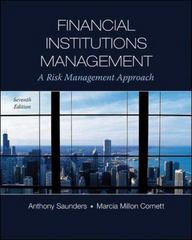Question
Investors are maximizing the expected return subject to not exceeding standard deviation they are willing to tolerate. There are 2 assets available for all investors.
Investors are maximizing the expected return subject to not exceeding standard deviation they are willing to tolerate. There are 2 assets available for all investors. The first asset is the stock market which provides the expected return of 15% and has the standard deviation of 20%. The second asset is the bank account which pays the interest rate of 1%. a) (1 point) You invest fraction of your portfolio into the risky asset and the rest into the riskless asset. What is the expected return of your portfolio? b) (1 point) You invest fraction of your portfolio into the risky asset and the rest into the riskless asset. What is the standard deviation of your portfolio? c) (1 point) Using a) and b) derive the capital market line. d) (1 point) Draw the capital market line you derived in c) (drawing approximately by hand is perfectly ok). e) (1 point) Assume that the maximum standard deviation the investor is willing to tolerate is 5%. Which fraction of the portfolio does the investor allocate to a risky asset?
Step by Step Solution
There are 3 Steps involved in it
Step: 1

Get Instant Access to Expert-Tailored Solutions
See step-by-step solutions with expert insights and AI powered tools for academic success
Step: 2

Step: 3

Ace Your Homework with AI
Get the answers you need in no time with our AI-driven, step-by-step assistance
Get Started


